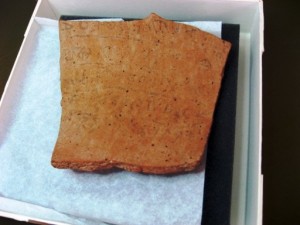 Jerusalem – A 3,000 year-old inscription discovered at a site where the Bible says David slew Goliath has been deciphered, showing it to be the earliest known Hebrew writing, Israeli archaeologists said on Thursday.
Jerusalem – A 3,000 year-old inscription discovered at a site where the Bible says David slew Goliath has been deciphered, showing it to be the earliest known Hebrew writing, Israeli archaeologists said on Thursday.
Subscribe to our Daily Roundup Email
The pottery shard with five lines of text in the proto-Canaanite script that was used by Hebrews, Philistines and others in the region was discovered 18 months ago.
The writing was decrypted by Gershon Galil of the University of Haifa who “has shown this is a Hebrew inscription,” said a statement from the university.
“The discovery makes it the earliest known Hebrew writing,” the statement said.
Carbon-dating has shown the inscription dates back to the 10th century BCE, making it about 1,000-years older than the Dead Sea scrolls.
“This text is a social statement, relating to slaves, widows and orphans,” said Galil, adding that both the words and the concepts used were specific to the Hebrew language and society.
The shard was found near the gate of a site known as Elah Fortress, about 30 kilometres (18 miles) west of Jerusalem, in the valley where the battle between David and Goliath is said to have taken place.
“The inscription is similar in its content to biblical scriptures, but it is clear that it is not copied from any biblical text, the statement said.

Can anyone please bring us the five line Hebrew inscription?
English translaton of the deciphered text:
1′ you shall not do [it], but worship the [Lord].
2′ Judge the sla[ve] and the wid[ow] / Judge the orph[an]
3′ [and] the stranger. [Pl]ead for the infant / plead for the po[or and]
4′ the widow. Rehabilitate [the poor] at the hands of the king.
5′ Protect the po[or and] the slave / [supp]ort the stranger.
VIN forgot to mention the penultimate sentence from that article:
“Finding such an early example of Hebrew makes it possible the Bible could have been written several centuries before the current estimates, the statement said.”
!!!!
What more do you need than the picture that was posted. Perhaps you didnt click on the pic????
English translaton of the deciphered text:
1′ you shall not do [it], but worship the [Lord].
2′ Judge the sla[ve] and the wid[ow] / Judge the orph[an]
3′ [and] the stranger. [Pl]ead for the infant / plead for the po[or and]
4′ the widow. Rehabilitate [the poor] at the hands of the king.
5′ Protect the po[or and] the slave / [supp]ort the stranger.
hmmm….. looks like a nice deliciouse piece of toast!?! sometimes toast can look like its got some uhh.. scriptures on it
It seems pretty speculative to me.
There is no Hebrew text. It was written before Hebrew as we know it was developed. The Hebrew we speak now is different from ancient Hebrew.
Proto Hebrew means it was the second form of Hebrew and not entirely pictorial as in the Torah. Though I cannot see the text in the picture of the stone but it looks like Royal Hebrew.
Dan:
The hebrew we speak (Lashon HaKodesh) is no different from ancient hebrew.
It is even supposed by traditional Jewish sources that Hebrew was spoken by Noach, Shem & Ever etc.
It is merely the alphabet that differs through-out the ages.
Ancient hebrew was written in various forms:
Words represented by pictures, shorthand (e.g. rav = reish beis meaning rosh bayis, a parent alphabet to hieroglyphics and some say ancient chinese)
Letters represented by pictures (following the same style as pictowords, with words spelled out)
And hebrew as we better know it, with traditional print-style block lettering.
It can be explained that proper lettering was used solely by scribes, to avoid commoners corrupting the detailed customs of it’s writing.
Common hebrew script followed either the short-hand or written style using pictographs pictorally depicting the meaning of each letter (e.g. Reish or Rosh = head, Beis or Bayis = house etc etc).
It can also be explained that the proper script was only used for Holy texts per se, and the pictographic script for all other texts.
This was written in old canaanite script using pictographic lettering (as opposed to pictographic wording).